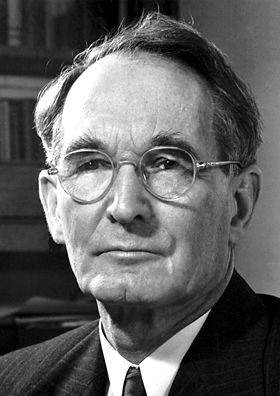Percy Williams Bridgman (nonfiction): Difference between revisions
No edit summary |
No edit summary |
||
| (2 intermediate revisions by the same user not shown) | |||
| Line 7: | Line 7: | ||
He made many efforts, all unsuccessful, to synthesis diamonds. | He made many efforts, all unsuccessful, to synthesis diamonds. | ||
His philosophy of science book The Logic of Modern Physics (1927) advocated operationalism and coined the term operational definition. In 1938 he participated in the International Committee composed to organise the International Congresses for the Unity of Science. | His philosophy of science book ''The Logic of Modern Physics'' (1927) advocated operationalism and coined the term operational definition. In 1938 he participated in the International Committee composed to organise the International Congresses for the Unity of Science. | ||
He was also one of the 11 signatories to the Russell–Einstein Manifesto. | He was also one of the 11 signatories to the Russell–Einstein Manifesto. | ||
| Line 23: | Line 23: | ||
== Fiction cross-reference == | == Fiction cross-reference == | ||
* [[Crimes against physical constants]] | |||
* [[Gnomon algorithm]] | |||
* [[Gnomon Chronicles]] | |||
== Nonfiction cross-reference == | == Nonfiction cross-reference == | ||
External links | * [[Francis Birch (nonfiction)]] - Doctoral student | ||
* [[John C. Slater (nonfiction)]] - Doctoral student | |||
* [[Gerald Holton (nonfiction)]] - Doctoral student | |||
* [[Physicist (nonfiction)]] | |||
* [[Physics (nonfiction)]] | |||
* [[Wallace Clement Sabine (nonfiction)]] - Doctoral advisor | |||
* [[John Hasbrouck Van Vleck (nonfiction)]] - Doctoral student | |||
== External links == | |||
* [https://en.wikipedia.org/wiki/Percy_Williams_Bridgman Percy Williams Bridman] @ Wikipedia | * [https://en.wikipedia.org/wiki/Percy_Williams_Bridgman Percy Williams Bridman] @ Wikipedia | ||
[[Category:Nonfiction (nonfiction)]] | [[Category:Nonfiction (nonfiction)]] | ||
{{Template:Categories: April 21}} | |||
{{Template:Categories: 1882}} | |||
{{Template:Categories: August 20}} | |||
{{Template:Categories: 1961}} | |||
[[Category:Percy Williams Bridgman (nonfiction)]] | |||
[[Category:People (nonfiction)]] | [[Category:People (nonfiction)]] | ||
[[Category:Physicists (nonfiction)]] | [[Category:Physicists (nonfiction)]] | ||
Latest revision as of 16:37, 7 January 2025
Percy Williams Bridgman (21 April 1882 – 20 August 1961) was an American physicist who won the 1946 Nobel Prize in Physics for his work on the physics of high pressures. He also wrote extensively on the scientific method and on other aspects of the philosophy of science.
Bridgman entered Harvard University in 1900, and studied physics through to his Ph.D. From 1910 until his retirement, he taught at Harvard, becoming a full professor in 1919. In 1905, he began investigating the properties of matter under high pressure, making significant improvements in machinery for generating high pressuer. This new apparatus led to an abundance of new findings, including a study of the compressibility, electric and thermal conductivity, tensile strength and viscosity of more than 100 different compounds.
Bridgman is also known for his studies of electrical conduction in metals and properties of crystals. He developed the Bridgman seal and is the eponym for Bridgman's thermodynamic equations.
He made many efforts, all unsuccessful, to synthesis diamonds.
His philosophy of science book The Logic of Modern Physics (1927) advocated operationalism and coined the term operational definition. In 1938 he participated in the International Committee composed to organise the International Congresses for the Unity of Science.
He was also one of the 11 signatories to the Russell–Einstein Manifesto.
Bridgman married Olive Ware, of Hartford, Connecticut, in 1912. Ware's father, Edmund Asa Ware, was the founder and first president of Atlanta University. The couple had two children and were married for 50 years, living most of that time in Cambridge. The family also had a summer home in Randolph, New Hampshire, where Bridgman was known as a skilled mountain climber.
Bridgman was a "penetrating analytical thinker" with a "fertile mechanical imagination" and exceptional manual dexterity. He was a skilled plumber and carpenter, known to shun the assistance of professionals in these matters. He was also fond of music and played the piano, and took pride in his flower and vegetable gardens.
Bridgman committed suicide by gunshot after suffering from metastatic cancer for some time. His suicide note read in part, "It isn't decent for society to make a man do this thing himself. Probably this is the last day I will be able to do it myself." Bridgman's words have been quoted by many in the assisted suicide debate.
In the News
Fiction cross-reference
Nonfiction cross-reference
- Francis Birch (nonfiction) - Doctoral student
- John C. Slater (nonfiction) - Doctoral student
- Gerald Holton (nonfiction) - Doctoral student
- Physicist (nonfiction)
- Physics (nonfiction)
- Wallace Clement Sabine (nonfiction) - Doctoral advisor
- John Hasbrouck Van Vleck (nonfiction) - Doctoral student
External links
- Percy Williams Bridman @ Wikipedia

